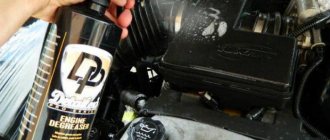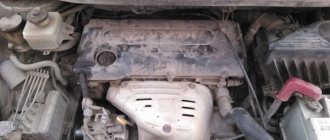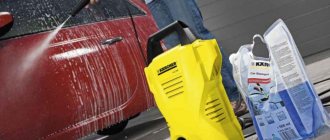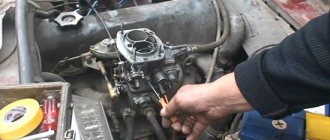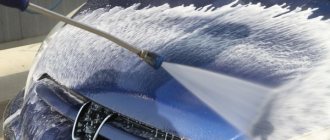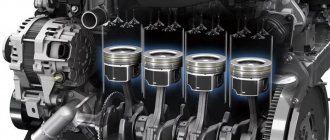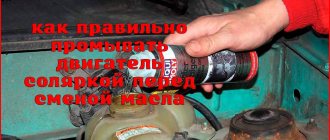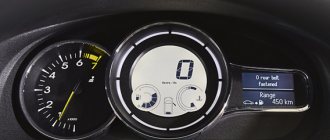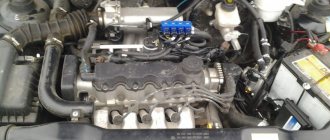It is worth noting that there are no exact instructions or specially designed instructions on how to properly wash the engine, and how often this should be done. But there are still several compelling arguments that explain why it is worth keeping the engine compartment clean. Let's try to find out why you need to wash the engine and how not to harm the car!
Engine washing technologies
At many car washes that offer engine washing, this operation is performed using a Karcher high-pressure apparatus. Let us say right away that this method is unsafe. For this reason, at such points there is an announcement that after washing the engine, its serviceability is not guaranteed. A directed jet of water can damage power unit components. It is clear that it is better not to use such sinks.
washing a car engine is also a risky operation . Aggressive compounds can damage plastic and rubber parts. Violation of the tightness of hoses, air ducts, etc. elements will lead to leaks, air suction and other problems. It is not surprising that many points offering such a service do not guarantee the serviceability of the motor after the procedure.
The least problematic is steam engine washing . This technology allows you to remove any contaminants without the risk of damaging components located in the engine compartment. A jet of dry steam effectively removes oil and tar deposits and dust layers, but does not flood the spark plugs or air intakes. The technology is little known in Russia, so very few drivers use it.
In general, engine washing with a guarantee is a rather rare service. For this reason, approximately every third car enthusiast prefers to perform such an operation with his own hands. There is a reason for this - you will try to do everything carefully for yourself, so the risk of damaging something is minimized.
Is it worth washing it yourself?
Knowing how to wash a car engine yourself safely with Karcher, you can easily get the job done without going to a service station. But keep in mind that in the absence of experience it is easy to make many mistakes and damage expensive components. It is best to entrust the work to professionals. They have all the necessary “chemistry” at their disposal, know how to properly wash a car engine with Karcher and guarantee that there will be no problems.
But is it possible to do everything yourself? This is real, but washing it yourself is fraught with the following errors:
- Using unsuitable detergents.
- Use of flammable cleaning compounds.
- Violation of the engine temperature regime..
- Washing the engine with Karcher under maximum pressure, which can deform fragile elements.
- Poor protection of electrical components, connectors and terminals.
- Inability to properly dry the components of the power unit after completion of work.
- Car wash with Karcher while the car is running, etc.
Positive aspects of car engine washing
A clean engine compartment is not only an aesthetic pleasure. Although this factor for many owners of modern iron horses is a strong argument in favor of the decision to wash the engine. The operational aspects are much more important.
Optimal heat dissipation
The most obvious benefit of regularly washing your car engine : removing dirt allows for improved heat transfer. The further chain of benefits is clear to any driver: the unit overheats less, the engine oil retains its working properties longer, and the life of the power plant increases.
Visual diagnostics
The second aspect is that on a clean engine, any leaks of technical fluids are immediately visible. That is, the owner gets the opportunity to notice the malfunction earlier and take action. It is always easier to solve a problem in the early stages, while the scale is not yet so large.
Preventing Electrical Problems
In winter, roads in large cities are treated with reagents that react with snow and ice to form saline solutions. If such splashes fall on a layer of dirt, conductive bridges are formed. Energy losses are possible, which has a bad effect on the operation of the battery, which already has a hard time in winter. In severe cases, short circuits occur.
Clean gasoline and diesel engines are not subject to such problems. It is extremely undesirable to wash engines in winter, but it is not necessary. Even if splashes of salt water and slush get into the engine compartment, they do not linger on the clean surface of the engine. For those who are particularly concerned about the condition of the car, it is enough to wipe the engine compartment with a clean rag.
Ease of maintenance
Everyone understands that it is more pleasant to perform all maintenance or diagnostic procedures in a clean engine compartment. It’s even more convenient to simply measure the oil level in the crankcase when the engine and other components are clean - you won’t get your hands and clothes dirty. The same situation applies if you need to remove the battery for charging or replace it.
Sink for sale
Trying to wash an engine before selling it is a very dubious endeavor. Many buyers are aware that they wash engines often in order to hide traces of recent engine repairs after heavy oil leakage. They have much more confidence in a motor covered with dry dust, which “has not been touched by a human hand.” And I completely agree with this opinion. Summary: before selling the car, if it is really dry, do not wash the engine.
Disadvantages of car engine washing
All the shortcomings boil down to one thing - the engine does not start. The reasons can be very different:
- wet terminals;
- flooding of candles and spark plug holes;
- short circuit.
In especially severe cases, especially when using high-pressure apparatus, mechanical damage to wiring and other small parts in the engine compartment is possible.
It is worth noting: such problems do not arise when dry washing a car engine . A jet of steam, even under pressure, has little kinetic energy, so it is not capable of causing physical damage to parts. It is easy to prevent the terminals and electrical wiring from getting wet by wrapping them in polyethylene and securing the “protection” with tape.
Selecting a detergent
Washing an internal combustion engine involves using only products intended for this purpose. The modern market offers a huge number of formulations in plastic and glass containers, aerosol cans, etc. This variety is supplied both in finished form and in the form of concentrates and gels that require dilution in the specified proportions.
Read the instructions carefully and try to use only products from trusted manufacturers, beware of counterfeits.
Most of these compositions are universal and are designed to combat a wide range of pollutants, but there are also narrowly targeted agents. The main criteria for choosing are: minimizing the impact on rubber and plastic elements, toxicity level, packaging and price. You should not purchase the most affordable products or overpay for expensive ones. It is better to opt for products in the mid-price range.
Is it possible to wash the engine compartment components yourself?
Approximately 20% of drivers do their own engine washing . Some people quite reasonably decide to save money, others simply don’t trust the “heart” of their car to washers recruited from an ad. Whatever the motive, enthusiasts roll up their sleeves and begin to restore order in the engine compartment of their car.
Let's say right away: washing an engine with your own hands is not such a difficult operation. You don't need to have any special knowledge or skills. It is enough to exercise prudence, be careful and follow the recommendations of the detergent manufacturer. We won’t just wash the engine compartment with water.
A few rules
Of course, every car enthusiast has his own preferences on how to wash the engine with his own hands . In addition, the procedure is described in the instructions for using the detergent. But there are rules that must be followed in any case.
Not cold, not hot
Rule one: wash a car engine at a unit temperature of about 40-50 °C. Take water at approximately the same temperature (can be 10 degrees hotter). If the surface is colder, oil stains and old dirt will be difficult to clean off. If you pour water on a hot engine, the metal may crack or become deformed due to a sudden temperature change. In this case, you will have to spend money on expensive repairs to the power plant.
Karcher is evil, although not absolute
Rule two: when washing the engine with your own hands, you should not use an AED. All these Karchers are good for washing the body, wheels and underbody, but in the engine compartment they can cause a lot of trouble. Everything under the hood is protected from splashes of dirt and rain, but a high-pressure jet can pierce seals and flood contacts or some electronic unit.
Protection in the form of plastic film and tape reduces the likelihood that you will damage one of the engine components, but not 100%. The only condition: you can use a high-pressure apparatus if you have good handling skills and are completely confident in your skills. And they are ready to take risks.
How to properly wash a car under the hood
Above, we figured out that with the right approach, you can get to work. But for this it is important to know how to properly wash a car engine with Karcher yourself. To resolve this issue, follow a number of recommendations.
Before you start washing, do the following:
- Remove all accessible protective and decorative parts/screens.
- Cover informational inscriptions and plates on tanks, panels and other elements.
- Make sure that the engine temperature before washing should be at 40-50 degrees. If it has a high temperature, detergents will evaporate from the car engine. With a lower setting, washing the engine with Karcher is not as effective.
- Protect all terminal elements, connectors, alarm elements and other electrical equipment from moisture. For these purposes, you can use regular tape and polyethylene.
If you have decided whether cleaning can be done using Karcher, please read the instructions below. Let's take a closer look at how to wash a car engine yourself using Karcher correctly:
- Apply the required layer of special “chemistry” to the elements that need to be washed. To do this, use a spray or brush.
- Wait a certain time for the product to penetrate into the composition. Information on this issue is indicated on the manufacturer's packaging.
- Make sure that the thickest dirt is liquefied.
- Set the required pressure. It is advisable that the engine flushing with Karcher be carried out under a pressure of no more than 100 bar.
- Wash off dirt from the car engine with a Karcher until the job is complete.
- Once cleaning is complete, dry the starter and alternator, and bleed the ignition coil and other accessible wiring components.
At the final stage, experts recommend washing the entire car body with Karcher to remove traces of “chemicals” from the surface. In this case, the answer to the question whether this can be done is always positive.
Use car shampoos for the engine compartment
Rule three: use special alkali-free do-it -yourself engine washing . Do not try to use washing powder or dishwashing detergent for this - it will hardly do any good, but problems are very likely. It is unknown how this chemical will affect hoses, gaskets and seals.
Washed? Dry it!
After washing the car engine with your own hands, you must thoroughly dry the entire engine compartment. High humidity is an enemy for any metal. It is advisable to use a compressor, but a vacuum cleaner with a blowing function will also work. Blow especially carefully around the terminal areas of the electrical part, otherwise oxidation and deterioration of contact may occur.
What to do if water gets on electrical equipment
Many people fail to wash their car engine with Karcher, which is why water gets on the electrical parts. As a result, the car may not start, jerking appears, the speed fluctuates, an engine error light comes on, etc.
Many people ask if there is any way to restore the car. Check again whether the battery and terminals are dry, whether the starter and fuel pump are working. If there are no problems here, check the ignition system:
- Remove water from under the distributor cap by blowing or wiping dry.
- Unscrew all the spark plugs, wipe the armored wires, and dry the spark plug wells.
- If there are separate coils for each cylinder, remove and dry them.
- Dry the spark plug wells.
- Check the engine sensor for serviceability. Perhaps “chemistry” or exposure to Karcher incapacitated him.
- Clean and dry the engine throttle body.
- Read the errors of the power unit if the “check” lights up and determine what exactly the reasons are.
As you can see, washing a car engine with Karcher is quite possible, but if done incorrectly, this leads to a number of problems with the electrical and mechanical parts of the car. To avoid problems, it is better to refrain from such a procedure or strictly follow the recommendations. If it is still necessary to wash the engine with Karcher, but there is no equipment and experience, it is better to turn to professionals.
People's opinion
We surveyed drivers in the Central region of Russia via the Internet. It turned out that about 46% of car owners never wash their engine compartments. Moreover, half of them simply do not have enough time or desire, while the other half do not do this on principle, supposedly after washing the engine there is a chance of getting into expensive repairs.
Another 36% of drivers wash their car engine themselves. The majority (16%) wash the engine compartment when it gets dirty. About 15% do this procedure regularly - once or twice a year. Approximately 5% admitted that they washed the engine only before selling the car.
Approximately 18% of motorists go to car washes to clean their engine compartment. If 9.5% regularly order the service, then 6.5% call only when the surface of the motor is very dirty. About 2% of drivers order a dry engine wash , preferring to overpay, but be sure that the car will not be damaged.
Where to go?
Now let's talk about another category of cars. The engine compartments of these cars, although they get dirty, are still not so intense. Car enthusiasts living in private houses with garden plots most often wash their cars themselves. Most owners, especially in large cities, clean their cars at paid car washes. Wash the outside of the body, clean the mats, and even the upholstery - great, but should we let these 21st century washers under the hood?
Let's first decide for what purpose the engine and engine compartment are washed.
Are you sure that all this intricacy of wires, tubes, hoses and devices will not be harmed by foamy chemicals?
Are you sure that all this intricacy of wires, tubes, hoses and devices will not be harmed by foamy chemicals?
Apply cleaning agent
After the engine has warmed up a little and some elements have been protected from moisture, you can begin spraying the engine cleaner. Modern engine cleaning products act quickly and effectively. If the engine is not very dirty, then it is not advisable to use too aggressive products based on petroleum products or solvents. They quickly act on oil contaminants and stubborn dirt, but at the same time they destroy rubber tubes and plastic in the engine compartment. It is better to use water-based cleaners.
General purpose cleaners that can remove grease can be used.
Depending on how dirty the engine is, you need to let the cleaning agent soak into the dirt film for 3–10 minutes. Do not allow the cleaner to dry on the engine after spraying. This will leave traces of the product.
If the engine is not very dirty, then you can do without using a brush. In case of heavy contamination and stubborn dirt, it is better to use a brush with a long handle. For some hard-to-reach places, you can use a toothbrush.
After applying engine cleaner and, if necessary, using a brush, thoroughly rinse the engine and its components with water.
We recommend: Pros and cons of diesel engine chip tuning
If you use a pressure washer, do not apply too much pressure or spray water too close to electrical connectors to avoid damaging them.
Allow the water to dry briefly, then wipe accessible engine parts and plastic parts with a clean rag before the water dries itself to avoid leaving any traces of dried water. After wiping with a dry cloth, start the engine and let it run for a few minutes. This will help the remaining moisture evaporate.
Once everything is dry and the engine has cooled, it would be a good idea to apply a special protective coating for the engine. You can also apply a protective coating to the engine compartment plastic and rubber tubes.
